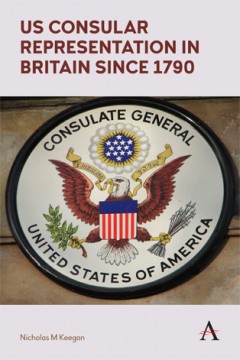US Consular Representation in Britain since 1790
By Nicholas M Keegan
Foreword by Barbara Stephenson
- About This Book
- Reviews
- Author Information
- Series
- Table of Contents
- Links
- Podcasts
About This Book
The book is meticulously researched, drawing mainly on archives in the United States and Britain and includes previously unpublished photographs. It is in three parts. Part I begins with a reminder of the early days of American independence and the formation of the new nation and is a useful backdrop to the rest of the book. This was a period of rapid growth which saw the creation and development of the State Department and the Consular Service. Accounts are given of the frequent legislative changes, the major weaknesses of the early Consular Service, the Spoils System which ensured that political allies or presidential fundraisers were appointed as consuls, the calls for reform, how the Consular Service lost its separate identity in 1924 when it merged with the Diplomatic Service to form the unified Foreign Service, and the amalgamation of the State Department and the Foreign Service in 1954.
Parts II and III form the major section of the book. Part II concentrates on the consulates and the people who served in them in Britain and pre-independence Ireland and is an overview of the American consular presence from 1790 to the present day. Topics covered include the wide-ranging extent of the consular network, British nationals who served as American consuls, consular families, office accommodation, furnishings and equipment of consulates, espionage activities conducted by the consuls in Britain during the American Civil War, how Texas and Hawaii had consulates in Britain before they became States of the Union, inspections of consulates, the dangers faced by consuls during the First and Second World War blitzes, and the lengthy attempts by women to become consuls and diplomats.
Part III consists of detailed histories of consulates in fifteen towns. These include the dates on which the offices were operational, short biographies of staff who served in them and an indication of their routine activities, including a few noteworthy incidents or highlights. The accounts are of varying length reflecting the duration of the consulates’ presence. The extent and scale of the former consular network can be appreciated from the list of locations and categories of consular offices shown in the Appendix. The book concludes with a review of how the consular function has evolved and kept pace with changing demands and needs. Although the Spoils System now exists for only one consular appointment, at a post which is not in the UK but is within the London embassy’s remit, it still thrives in those embassies where career consuls and diplomats report to an ambassador who may be a political appointee. This is particularly the case in a number of European posts.
Reviews
‘Nicholas Keegan’s US Consular Representation in Britain since 1790 is a masterful addition to American diplomatic history. It examines the consular branch of the United States in its most important ally in great detail from the immediate post-revolutionary years to 2017. He also describes the US consular system, its growth and its problems, warts and all.’ — Charles Stuart Kennedy, Oral History Director, Association for Diplomatic Studies and Training, Arlington, Virginia, USA
'… a substantial contribution to the history of US diplomacy from 1790 to 2018 … the scholarly value of the work is enhanced by the detail on the individual consulates which will make this book essential for anyone doing research in Anglo-American diplomatic relations … [the] work stands not only as an invaluable contribution to US diplomatic history in its own right, but provides scholars with new sources, ideas for future research.' — Bernadette Whelan, Professor, University of Limerick, Ireland.
The book 'opens the door to forgotten and untold accounts of America's presence in the United Kingdom - telling stories our early consuls never told about themselves or even dreamed would be of interest to modern readers'— Ambassador Barbara Stephenson - at the time, President of the American Foreign Service Association
Author Information
Nicholas M. Keegan, a former civil servant, has spent many years researching consular representation, first for his PhD, and then for the present book.
Series
Table of Contents
Dedication; List of illustrations; Preface; Acknowledgements; Introduction; PART I; 1. Early colonial history and American independence; 2. Creation and growth of the State Department; 3. Establishment and development of the Consular Service; PART II; 4. US consular representation in Britain; 5. Impact of the Civil War and the role of American consuls in Britain; PART III; 6. Consular Posts and Consular Agencies in Major British Cities; 7. Belfast; 8. Birmingham; 9. Bradford; 10. Bristol; 11. Cardiff; 12. Dublin (up to 1922); 13. Dundee; 14. Dunfermline; 15. Edinburgh & Leith; 16. Falmouth; 17. Liverpool; 18. London; 19. Newcastle upon Tyne; 20. Southampton; 21. Stoke on Trent; 22. An evolving, adaptive service; Appendix: Locations and categories of consular offices; Sources; Bibliography; Illustration captions; Illustration credits; Notes; Index.
Links
Stay Updated
Information
Latest Tweets



